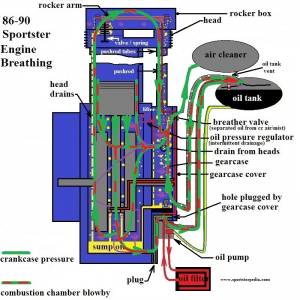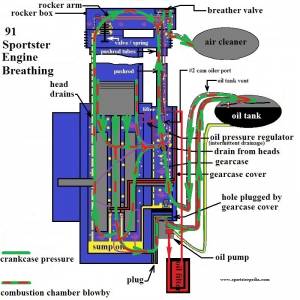Table of Contents
This is an old revision of the document!
REF: Engine Mechanicals
Evo Crankcase Pressure and Engine Breathing
See also in the REF section of the Sportsterpedia:
Crankcase Pressure
Sub Documents
In the crankcase air system
Crankcase air pressure is mainly generated by the up and down movement of the pistons.
Additional air pressure is created by blowby from the combustion chambers past the rings and into the crankcase.
Additional air can be created by other small air intake areas as well as from gasket leaks.
Crankcase pressure also initiates the splash and mist process (the movement of the pistons and flywheels splash oil around in the engine).
The piston motions create a pulsating blast of air pressure (push pull condition as each piston rises and falls).
The pressure in the crankcase is not from oil pump pressure
Static oil pump pressure has already been dissipated by the time it reaches the crankcase.
(although it takes static oil pressure to get the oil from the pump to the crankcase)
Crankcase (CC) pressure will have an average and constant change in velocity.
Gravity oil (from the drain ports in the heads) returns to the crankcase.
Gravity oil (from the pushrod tubes) returns to the gearcase.
Oil in the crankcase adds resistance to the air pressure generated (raising the pressure).
Role of the breather valve
CC pressure both pushes to and sucks from the breather valve.
The breather valve allows for controlled air pressure to both leave and enter the engine to obtain what is referred to as a “slight running vacuum” in the crankcase.
If the breather valve isn't there;
The pressure generated from upstroke and downstroke would both push all the under piston air volume out of the engine and back into the engine.
(including any oil that was suspended with it.
Also that would create thicker oil suspension and more oil blowing out of the engine but not returning.
The volume between positive and negative pressure decreases as RPM goes up.
The speed of the breather valve action is important as it has to keep up with RPM changes.
See also, Example of Air Pulses Using a 1000cc Motor, in the sub documents at the top of this page.
Oil Tank's Role vs Wetsumping
See the full article, * Oil Tank Pressure, in the REF section of the Sportsterpedia.
There should not be any pressure difference in the oil tank than the engine although it does transfer pressure.
The oil tank vent line to the cam chest allows the pump to send oil and CC pressure to the tank without over pressurizing the inside.
So if you have pressure in your oil tank and the vent to the cam chest is not blocked then the cam chest is also pressurized.
If the cam chest is holding pressure, then your breather valve can not be venting properly.
Bottom line is that if the vent system is working properly, you shouldn't have excessive pressure build up in the oil tank. 1)
Lowering the oil level in the oil tank
It has been said by many that lowering the oil level in the oil tank will stop oil puking out the breather.
While this may work in application, by design, you should not have to lower the oil level.
This practice is not just restricted to rubbermounts although due to the CC pressure change in 04, it is a more accepted practice.
The tank acts as an oil / air separator like the breather valve but the air only expels the engine from the engine breather vent.
Affects of the 45° Rod / Piston Arrangement
Since Sportster piston movement is not equalized, we get the potato, potato sound we all love but the equilibrium in the crankcase is off by design.
This constant push / pull from offset pistons contributes to an imbalance of pressure that needs to controlled.
See, Affects of the 45° Rod / Piston Arrangement, in the sub documents at the top of this page for more information.
Differential Pressure (vacuum and air pressure)
Vacuum and (positive) air pressure are the terms that describe the amount of molecules of a gas in a given unit of space. 2)
More molecules inside the engine than outside = inside air pressure.
Less molecules inside the engine than outside = inside is vacuum pressure.
57-76 engines are subject to the most volume of vacuum in the crankcase, rocker box, oil tank and primary compartments.
77-85 engines are subject to the same volume of vacuum in the gearcase, rocker box, oil tank, gearcase and primary compartments.
Oil scavenging:
Positive crankcase air pressure aids scavenging. It pushes the oil to the oil pump.
Negative (vacuum) pressure makes the pump's job harder. High vacuum makes the downstroke push to scavenge less powerful.
The oil pump wants to receive more oil, high vacuum slows down the delivery of oil to the oil pump.
Ring seal and pumping loss:
Too much positive pressure is harder on the pistons on downstroke since they are having to expel that air pressure on the way down.
High positive air pressure in the crankcase is said to rob horsepower.
So it is good to have a slight vacuum in the crankcase when the downstroke begins.
A vacuum condition when downstroke begins lessens the restriction on the descending pistons and doesn't lower overall horsepower.
In most engines negative crankcase pressure allows less ring pressure and the combination of both means more hp. 3)
Over the years folks have used exhaust system energy to pull pressure from the case for this reason.
Guys have won championships with an engine that had an electric vacuum pump to reduce (positive) crankcase air pressure.
Crankcase pressure in these engines fluctuate wildly from positive to negative. 4)
However, high vacuum can have a dramatic affect on scavenging.
See, Differential Pressure, in the sub documents at the top of this page for more information.
Symptoms of High Crankcase Pressure
Picture a balloon inside the engine being blown up.
It puts internal pressure against the weakest structural points (gaskets and seals).
Symptoms include: 5)
Sweating oil from the cylinder base gaskets and rocker boxes.
As well as the push rod tubes and lifter blocs on the other side.
Blowby
Normal blowby:
In the absence of any blow-by getting past the rings, the crankcase alternates from atmospheric (pistons down) to a vacuum (pistons up). 6)
But in the real world, a little gets past the rings, so there's a net outflow equal to that.
Conventional rings have a ring gap and the combustion pressure is very great. 7)
So you can bet some of this tremendous pressure is entering into your crankcase instead of 100% of it exiting your exhaust pipes.
Excess blowby:
The ringlands on the pistons 'should be' sealing but sometimes are not.
You can end up with 'out of round' or scratched cylinders from different conditions.
Imperfections in ring seal increase the amount of air from the combustion chambers getting into the crankcase.
See, Blowby and Ring Seal, in the sub documents at the top of this page for more information.
What causes extra air in the crankcase (air leaks)?
Ring seal, as mentioned, is not as good on higher RPM even on a healthy engine.
Gasket / air leaks can introduce more air in the crankcase.
They allow more air into the engine that add to the positive and take away some of the negative (vacuum).
So the introduction of air leaks into the crankcase lowers the RPM at which pressure changes affect the system.
Worn / stiff breather valves will allow more or less air at atmosphere into the crankcase.
This changes the average vacuum and contributes to higher positive pressure on downstroke.
The timing of the breather valve opening and closing can also bring in air to the crankcase during upstroke.
The faster it closes, the more vacuum is kept in the crankcase on upstroke.
The slower it closes, the less that vacuum can be contained in the crankcase.
The breathing system is designed for a one-way valve venting system.
Air goes out but doesn't come back in.
Air leaks (into the engine) will increase positive pressure and air / oil density = oil puking out the breathers.
Some potential air leak areas are in the pic below.
If these areas allow air to be pulled in the engine on upstroke, the added air will compound any other existing breathing problems.
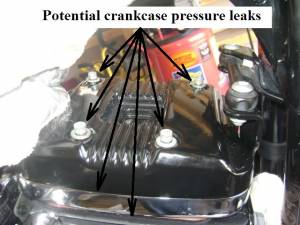 8)
8) 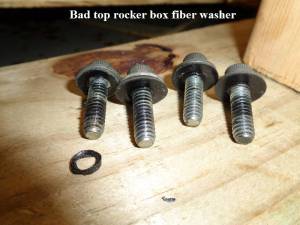 9)
9)
Why is the ratio of positive and negative pressure important?
It takes a balance of the two to run a Sportster engine.
Piston upstroke creates negative pressure and suction of oil from the sump.
It pulls oil up in the form of oil mist to be tossed around on the moving metal parts.
So it is important for lubrication and it keeps down aeration in the oil.
But without the reciprocating piston downstroke, there wouldn't be a lot of force to help splash it around other than the spinning wheels.
The upstroke pulls oil into suspension (air/oil mist) so the downstroke can help blow the mist around working in conjunction with flywheel and cam rotation.
Negative pressure is also important for ring seal as it allows the rings to seat better on high RPM.
Too much negative pressure is detrimental to oil scavenging as it allows thicker oil to be pulled up into suspension.
The thicker oil separates slower and can wrap around the flywheels (instead of moving toward the scavenge port in the sump).
The bulk of gravity oil on the sump floor is heavier than the moving air.
But the spinning action of the flywheels can pull that oil up to be slung around the wheels creating more drag as it does.
So it's important to get the excess oil in the bottom out of the engine as fast as possible to keep down flywheel drag.
That's where the positive pressure comes in.
Positive pressure is important for oil scavenging as it works in conjunction with splash lubrication as well as the suction of the oil pump.
The positive pressure generated by the downstroke pushes oil toward the scavenge pump to be sucked vertically into the oil passage to the pump.
So there is a balance of positive and negative pressure that has to be maintained for overall engine operation.
The role of positive and negative pressure can be confusing.
Even though there is a positive 'push' on internal pressure through piston downstroke, the overall internal pressure is still negative.
It's just less negative than it was before the downstroke until high RPM changes that.
This creates a pulsing effect on oil in the sump which helps shift the oil toward the scavenge port.
Even though there is normal blowby throughout the RPM range, the vacuum created buffers that.
Engine Breathing
Typical automobile V-8 engine breathing: 10)
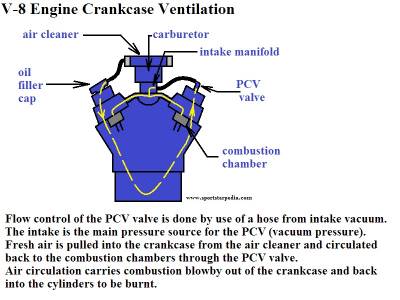
Engine ventilation is connected to the rockerbox, crankcase, cam gear case and the oil tank. 11)
If you blow down the oil tank line…air comes out the rockerbox vents (or cam breather hose).
There are airways linking these compartments together and in looking at these airways.
If one pressurizes, they all pressurize and air can pass between them;
- Rocker Box:
- Pushrods connect the rockerbox to the gearcase.
- Gravity oil:
- 03 and prior: Heads drain oil to the crankcase sump (through passages in the cylinders).
- 04 and Up: Heads drain oil to the gearcase (through passages in the cylinders and gearcase wall).
- All: Pushrod tubes drain oil into the gearcase.
- Gearcase / cam chest:
- Rockerbox oil return connects to the gearcase.
- Airways thru the wall joins the sump and the scavenge side of pump.
- Piston downforce pumps air and oil from the sump to the gearcase compartment.
- This would equalise air pressures in the two chambers.
- Crankcase:
- Piston downstroke creates a positive pressure against the oil in the sump.
- This forward pressure is connected to the oil tank thru the oil pump.
- It also helps to push oil into the scavenge chamber from the sump upward into the scavenger side of the oil pump.
- Piston upstroke creates a negative pressure (noted as vacuum for this article).
- Some of the oil either draining to the sump or collected from the sump is picked up by the vacuum in the form of oil mist.
- Also some of the oil is picked up in the form of oil droplets (or splash oil) and is moved around by the next positive pressure condition.
Splash oil is further moved by the action of the flywheels, connecting rods, cam gears, air pressure and gravity.
- The pinion gear shaft is hollow and connects the crankcase to the gearcase (but would only pass air with the engine off).
- 03 and prior engines connect rockerbox oil to the crankcase.
04 and up do not.
- Oil Pump:
- The pressure side of the oil pump is fed from the oil tank and is connected to the rocker box and the crankpin.
- Gravity from the oil tank initially feeds the oil pump.
- But once the engine starts, the motion of the gerotors creates a suction in the feed line from the tank.
- Pressure in the oil tank also adds pressure on the gravity feed to the pump.
- The pump creates non pressurized oil flow from the feed gerotors.
- Restrictions (oil line / feed passage sizes) to the oil filter pad and through the engine create back pressure on the pump.
- This pressure builds and is sent to the lifters and rocker box as well as the crankpin through the hollow pinion shaft.
- The pressure is increased at the pump as oil flows through more restrictions to get to these places.
(strictly as a non tested example, 10 psi on the feed side of the pump may equate to 4 psi or lower once it reaches the crankpin)
Pressure is restricted in the cam cover,
Less restricted with the wider opening at the pinion shaft bushing,
Then restricted again thru the shaft hole and the turns in the flywheel to the crankpin.
- Once the pressurized oil reaches the rocker arms and crankpin, the pressure is released into the wider openings in the oil path.
From there it is added to and becomes a part of crankcase pressure and is used and vented as such.
OEM oil paths and engine breathing drawings:
| 92-97 engine breathing paths. 14) | 98-03 engine breathing paths. 15) | 04 and up engine breathing paths. 16) |
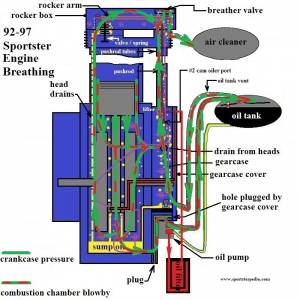 | 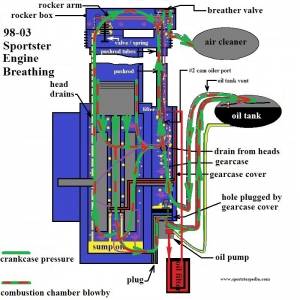 | 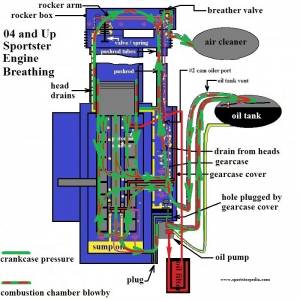 |
| Testing CC pressure on the dyno. 17) |
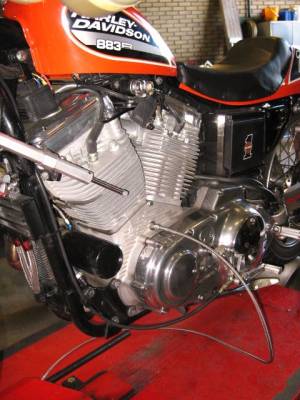 |
Revised crankcase breathing is an area where you have huge potential to create unintended consequences.
Few if any really understand the ifs, ands and buts of all the factors the factory took into consideration when they designed the system.
Gappless rings while great for ring seal are another area where you can get in over your head if you are not careful. 18)
Wet sumping is only one potential problem you may encounter with them. 19)
In the right application they can not be beat but you better have your ducks in a row.
Buell crankcase breathing:
| This is a Buell XBRR with reed valves through the cam chest wall. 20) | |
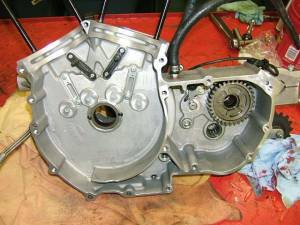 | 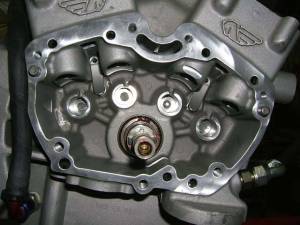 |
Engine Breather Valves
Sub Documents
- Breather Valves (1957-Up) (list of breather valve changes)
- Breather Venting / Relocation (list of breathing mods and aftermarket breathers)
Symptoms of Breather problems
The most noticeable signs of breather valve problems are weeping gaskets or oil excessively leaking out the breather or puking oil out of it.
When the umbrella(s) gets hard, it doesn't flex well to allow the engine to breath out on exhale.
Then the trapped in air is compounded on the next stroke. The excess air contributes to more vacuum created and implodes the gaskets.
Or it contributes to too high of oil density and slings excess oil out. Other factors are involved so results will vary.
Wetsumping during shutdown periods is a condition of bad oil pump sealing, bad check valve or regulator (if equipped) sealing.
Click here to read the full article on wetsumping in the REF section of the Sportsterpedia.
The foregoing addresses the affects of wetsumping upon with the engine running.
Later engines are not competition engines. Maybe the earlier Sportsters were, but those days are long gone. 21)
Wetsumping (at sustained high RPM) is a condition when the oil pump isn't removing the oil as fast as it's feeding it.
If the cam box fills with oil, it comes out the breather and right to your air cleaner. 22)
It's been a chronic issue on XL's for years, happens on the 5-speed bikes as well as the 4-speeds and the ironheads.
But often on the head breather models (91-up), you never know like you do on earlier bikes with the breather on the cam box (pre 91).
- Wetsumping can also be attributed to the Density of the air / oil mix in the crankcase. 23)
- The higher the density (not volume) of the fluid (air / oil mix), the more it drags on the rotating parts it contacts.
- As the density increases so does the fluid drag it imposes on the rotating parts (read flywheel assembly).
- This drag robs power. That's why we mess with it, to reduce the power loss.
- Example: If they are the same size (volume), what takes less power?
- Stirring a cup of coffee or stirring a coffee milkshake? It's the one that's less dense.
- So now we know that less drag = more horsepower and the air is the medium that gets the oil out of the cases.
The 'leaner' (less oil in the air), the less the drag (air / oil is less dense). 24)
The oil pump was updated in '98 and then in '07 and you rarely see this anymore (while putting around town).
But it still happens on high rpm and race motors from time to time.
It's always the best sealed motors that have the issue, especially gapless ring motors.
Vacuum (45° configuration as mentioned above) in the crankcase interferes big time with scavenging.
The 98-up style pump can be fitted to the older bikes (they've even been fitted to ironheads).
The late model bikes can easily wet sump if ridden aggressively on the street, however. 25)
And they've been known to wet sump with only 3 back to back dyno pulls.
The results are dramatic when it happens. It is not anything like a barely noticeable loss in performance.
The scavenging gets behind to some degree in a single drag strip run.
Beyond that, about all you can do is lower the oil pressure.
But don't go down that path unless you establish for sure you are wetsumping and other measures won't fix the situation.
Read more here on a Homemade Oil System Bypass for reducing the oil pressure in the REF section of the Sportsterpedia.
This mod will send a small amount of pressure side oil back to the tank instead of into the engine.
Engine Venting Mods
In addition to the above, I also did a bunch of testing of the aftermarket breather check valves from Spyke and Hayden. 26)
(and even did some experiments with vacuum pumps and the like)
Did some magazine articles here and there at the time. The motor was remarkably insensitive to anything I did with the breathers.
Like I said, the only thing I could get to show up on the Dyno sheet at all was the removing of the blow-by from the intake tract.
Engine breathers control when CC pressure exits the engine.
So when you're discussing engine breathing mods, you're also discussing changing crankcase pressure.
Revised crankcase breathing is an area where you have huge potential to create unintended consequences. 27)
Few really understand the ifs, ands and buts of all the factors the factory took into consideration when they designed the system.
The stock vent system doesn't keep up with the increased pressures and volume of air from modified engines very well.
The MoCo somehow balanced the engine design factors to come up with a compromise that worked.
Once you change CC pressure / compression ratio and etc, that equilibrium is disturbed.
aswracing on venting mods: 28)
I've induced scavenging issues mostly from using gapless rings. But not from venting mods.
However, I've dyno tested venting mods until I'm blue in the face and never found a single horsepower there.
(except for pulling the blow by out of the intake tract, which is good for a small across the board improvement)
S&S cases have no scavenging issues due to the strategic placement of the reed valve (in the sump).
The scavenge inlet sees pressure but is isolated from the vacuum when the pistons go back up.
Crankcase Pressure Testing
Sub Documents
Crankcase pressure can be tested to see what the pressure is doing, when it does it and the affects of changes to the breathing system.
Testing can also be done to determine pressure issues before they become a big problem as well as diagnosing that there is one.
57-76 engines:
Vacuum in 57-76 engines should be checked to make sure it's not creating too much especially if oil leaks / weeps keep happening.
If everything is percolating nicely, a test then is a good base line. Oil leaks can easily be a result of too much vacuum.
And that depends on gasket / seal conditions and limits. The head drains are also possible vacuum routes, thus rocker boxes and down.
How many have had reoccurring pushrod tube leaks? Surely the 3rd or 4th set of seals were installed correctly.
Too much vacuum can implode the tube seals. Testing the amount of vacuum at that point may reveal too much.
What can you do if you have too much vacuum in 76< engines?
Check for the breather gear out of time or gasket / seal leaks.
Seal leaks on downstroke lower mean pressure and allow more vacuum to generate on upstroke.
Other things to consider are a plugged / kinked vent tube or breather vent mods that could have raised vacuum.
In the sub documents above are some examples of different testing that was done on Evos.
Below are some noted results of that testing.
Each of the tests above do basically support each other given the different variables.
But the results have to be taken in context as each have different criteria for testing.
- Testing from DK Custom:
- The criteria for their testing was to see how much air was passed out the breather vents (outside the engine) at idle, under a load, at cruising speeds and on throttle let-off' for different model engines. They sell modified breather venting configurations and was doing some R&D presumably in the interest of same.
- Their testing supports bustert's slack tube testing as normally at most of the RPM range, there is more vacuum than positive pressure. And it's the positive pressure that leaves the engine. Therefore, their results for the Sportster are equaled out more. Even though there is normal blowby throughout the RPM range, the vacuum created buffers that.
- In example, 15“ of vacuum at idle that all of a sudden is hit by 5” of positive pressure rolling the throttle still yields 10“ of vacuum at the time. So there would be no air moving into the balloon or container at that point. In theory and during that transition from 15” to 10“ vacuum, more oil is pushed toward the scavenge hole in the sump, the pump gets a fatter supply of oil to send to the tank, pressure goes up in the air space in the tank due to the restriction size of the vent.
- Testing from bustert:
- This was a test of the differential pressure changes (inside the engine) through the RPM range up to 6000 RPM.
- You may have read and heard from many sources that the Sportster requires a 'slight vacuum'. But the slack tube testing puts a visual to the process showing that the 'slight vacuum' is not really a stagnant number but a constantly moving range.
- Testing from aswracing:
- Dyno testing was with the normal head breather vents in place (with and without the timing hole plug removed) to see if either would show increased HP over the other.
The dyno sheets show the affects (HP changes) between the stock setup and with addition of air induced into the engine through the RPM range.
However, it does not show internal pressures during the testing. - The testing revealed a dip in performance starting around 5700 RPM which coincides with bustert's slack tube testing showing positive and negative pressure equaling out up in that range. But the Dyno test is a load test as where the slack tube was done with no load on the engine… more variables.
What does all this mean?
The testing shows that there is more potential for crankcase pressure problems in the high RPM range.
There will be a normal amount of air passing the rings by design.
As the rings heat up and expand, there will be less air passed by them until you run up past the 5000 RPM range.
Then, questionable ring seal comes into play to pass more air through the rings which creates more positive pressure in the crankcase.
So normal blowby increases with engine speed.
Couple that with the increasing speed of the pistons which helps to equalize positive and negative pressure during operation.
As engine speed increases, there is not as much time to build vacuum on upstroke or positive pressure on downstroke due to the faster changing piston positions.
Just as you can inhale air slowly and fill up your lungs but faster breathing will not allow you to fill them due to the faster time that you exhale.
This would make for a shorter range of (both vacuum and positive) pressure that would be able to build in the crankcase.
So the internal pressure is more stable until extra air (or blowby) is induced into the crankcase.
Vacuum Pump for Reducing Crankcase Pressure
Most of the information on the web involves the use of a vacuum pump on autos.
There's not much published on using them with motorcycle engines.
That doesn't mean anything other than speed shops may not want to divulge their secrets. Also big pumps are for big displacement autos.
You can use a vacuum pump that's too big for a Sportster engine and cause more harm than good.
They are used for compensation as well as for better ring seal, but mostly advertised for better ring seal.
There are pumps spec'd for vacuum measurements and also ones spec'd by RPM range.
But, along with the addition of a vacuum pump, there is also the addition of a performance multi-stage oil pump.
If you vented from the crankcase area:
Splash is an important element in the sump area. Too much vacuum and you lose scavenge ability of the oil pump.
You may be able to tap into the side-top with a vent line and a reed valve.
The more the vacuum, even lower the positive will begin.
The rings act as a buffer between these two conditions as excess pressure could run both directions.
But positive pressure aides in oil scavenging.
So lowering positive pressure by default also hinders scavenging.
That's why racers with vacuum pumps use multistage scavenge pumps to account for the imbalance to scavenge and improve it.
Regardless, it's evident that some racers use vacuum pumps to increase vacuum pressure in the crankcase of a Sportster engine. 29)
It's been said that positive crankcase pressure upon piston upstroke gets between the rings and basically causes bad sealing at the ringlands.
This is also in the high RPM range when ring flutter is present. So there are several things happening then.
But racers record higher power when using a vacuum pump.
However, it has also been said that inducing higher vacuum in a street engine may do more harm than good. Lower RPM may suffer from the imbalance.
A vacuum pump, in general, is an added benefit to any engine that is high performance enough to create a significant amount of blow-by. 30)
(that's high performance enough…. not worn enough)
It will, in general, add some horse power, increase engine life and keep oil cleaner for longer (in a high performance engine).
The first thing that happens on downstroke is that positive pressure (greater than atmosphere) is generated due to the restrictions of:
- Case volume
- Path to the vents
- Vent hole size
- Vent line (if applicable) length
- Any induced air from the breather valve(s) not closing properly
These things will bring the pressure inside to higher than atmosphere, else there would be nothing to expel.
As the air is pushed out of the vent, at BDC, the air returns to atmospheric.
That is the problematic condition, the higher pressure before returning to atmosphere.
Blowby adds to positive pressure which throws out the balance.
- Using X (+1) as positive and Y (-1) as negative pressure.
- In a perfect world, X goes down and Y comes up —— X+Y=0.
- Add ring blowby and you get —— X+1>Y—— or the real result.
Balance is off by nature of the moving parts.
The pistons move up and down almost together.
That makes the push/pull environment more violent. - Now add a vacuum pump with Z (-1) amount of pull.
Now you get X+1=Y-Z… seems the balance (to zero) is restored even though positive pressure is compiled of blowby.
But the lower the negative pressure is at the beginning of the downstroke, the lower the next positive pressure will be. - If you are generating 2 psi of positive pressure on downstroke but reduce it's beginning surge to -1 psi (Z),
the result will be only 1 psi of positive pressure during downstroke.
-1 (+) + 2 equals +1.
Another example:
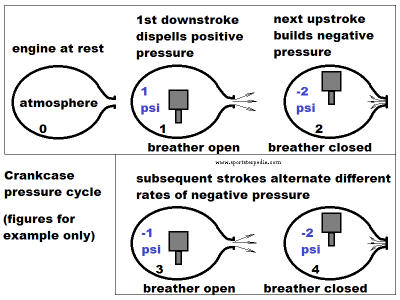 31)
31)
Considerations for running a vacuum pump:
- A vacuum pump will create negative pressure in the crankcase. 32)
And that negative pressure will remove air mass and create less atmosphere on the bottom side of the rings.
(which creates a more stable environment)
So positive pressure is removed around the rings / ringlands.
There is no opposing force to keep the rings from seating on the ringland bottom.
On piston upstroke, the rings sit against the bottom of the ringlands.
On piston downstroke, the rings sit against the top of the ringlands. - The more stable environment change has allowed engine builders to reduce the size and tension of the ring stack; 33)
creating less friction, less heat, and less power being robbed from the combustion process.
Better ring seal is a nice advantage too. - The major gain with vacuum pumps comes from sealing the top ring better on the intake stroke; 34)
Pulling more air and fuel in with better ring seal, which allows for a bigger charge to be burned and making more power. - It’s not just the rings, it’s the whole package; pistons, rings, quality machine work to get the right cylinder finish, and a proper tuneup. 35)
- Piston downstroke (positive pressure) aides in sump oil scavenging.
And unfortunately, vacuum pressure fights the oil pump.
You need more positive pressure in the crankcase to help force the oil out of the sump as the oil pumps pulls vacuum on the sump.
However, if the vacuum on upstroke is lower, there will be more than normal negative head pressure by the time the downstroke happens.
Less pressure on downstroke means less force pushing against sump oil to scavenge.
Too low of vacuum head pressure when downstroke begins and you end up with more oil left in the sump.
(which marches toward a wet sumping condition)
So a multi-stage oil pump that doesn't depend on crankcase pressure assist will be better suited with this setup. - The updraft on sump oil is lower, creating more loose suspended oil.
The updraft is what aides in bringing oil into suspension with the air.
Once suspended, the 'mix' is able to 'float' and it will move in the same fashion that air will move (wherever it's pushed or pulled).
The mix separates on impact when it hits the crankcase / cam chest walls, cams / bushings etc.
Loose suspension (lower pressure) drops the air /oil mix ratio faster upon impact.
Tight suspension (higher pressure) drops the mix slower.
During high CC pressure, more oil is left into suspension by the time it reaches the breather valve.
When it hits the breather valve (on impact) more oil stays in suspension past the valve and out the vent.
Lower pressure hitting the valve drops the ratio fast enough that less oil is left in suspension by the time it reaches the vent. - Lower vacuum in the crankcase also hinders splash oil due to the lower updraft.
So it is possible to starve splash lubrication in the interest of lowering crankcase pressure.
Windage is also lowered and this is the propellant for splash oil. - Crankcase pressure is lowered even more below atmospheric pressure.
However, combustion chamber blowby (thru the rings) adds positive pressure to the crankcase at the same time it's being lowered.
So there is a balance there like when you turn on a single water faucet.- 1/2 a turn cold, half a turn hot gives you warm water.
- 1/2 a turn cold, full turn hot makes the water hotter.
- Gapless rings allow less blowby during upstroke which creates less fill pressure in the crankcase.
(thus, lowering vacuum head pressure at piston downstroke)
This may be the reason gapless rings increase wet sumping.
In summary:
Racing bikes can pump enough vacuum into the engine to create better ring seal = more power at high RPM.
This is fine as long as the oil pump system is modded to return more oil to the tank by itself, without the need for CC pressure assist.
The use of a vacuum pump on a Sportster street engine can easily create wet sumping issues.
Street bikes will only occasionally see high enough RPM to warrant a vacuum pump but even then still running on the OEM oil pump.
So the possibility for wet sumping goes up on them.
If you want to run a high level of crankcase vacuum (18 inches HG or more); 36)
There must be provisions in the engine to supplement the lubrication loss (splash oil through windage).
There can be problems with at least wristpin lubrication also.
Running a vacuum pump also would require scheduled diagnostics.
The amount of vacuum pulled depends on the general status of crankcase pressure at the time of use.
(I.E. current conditions such as; ring seal, breather valve wear, vacuum leaks, head valve leaks etc.)
You can't just install one and forget about it else you've defeated the purpose of installing it.
So it is possible to run a vacuum pump on a street engine.
But there are more considerations than just hooking one up.

